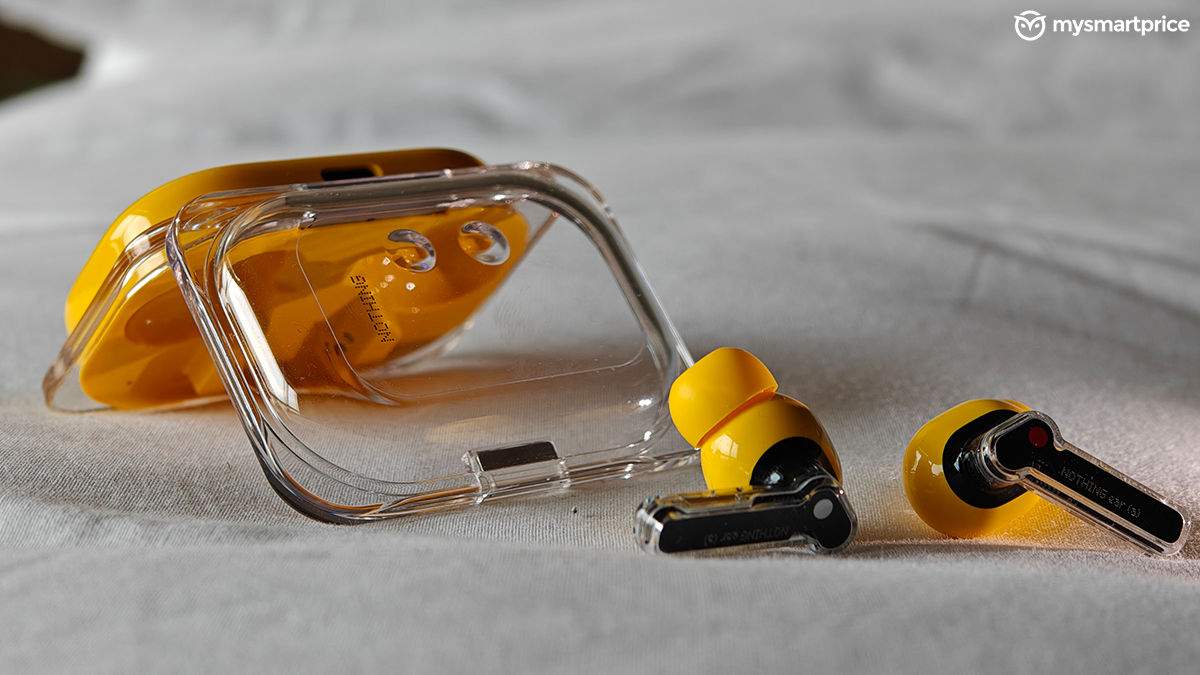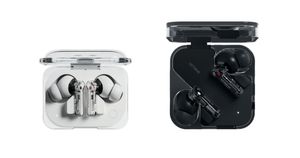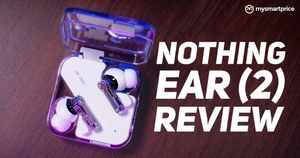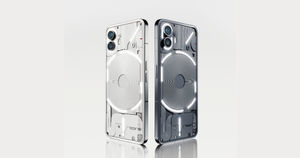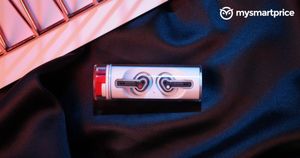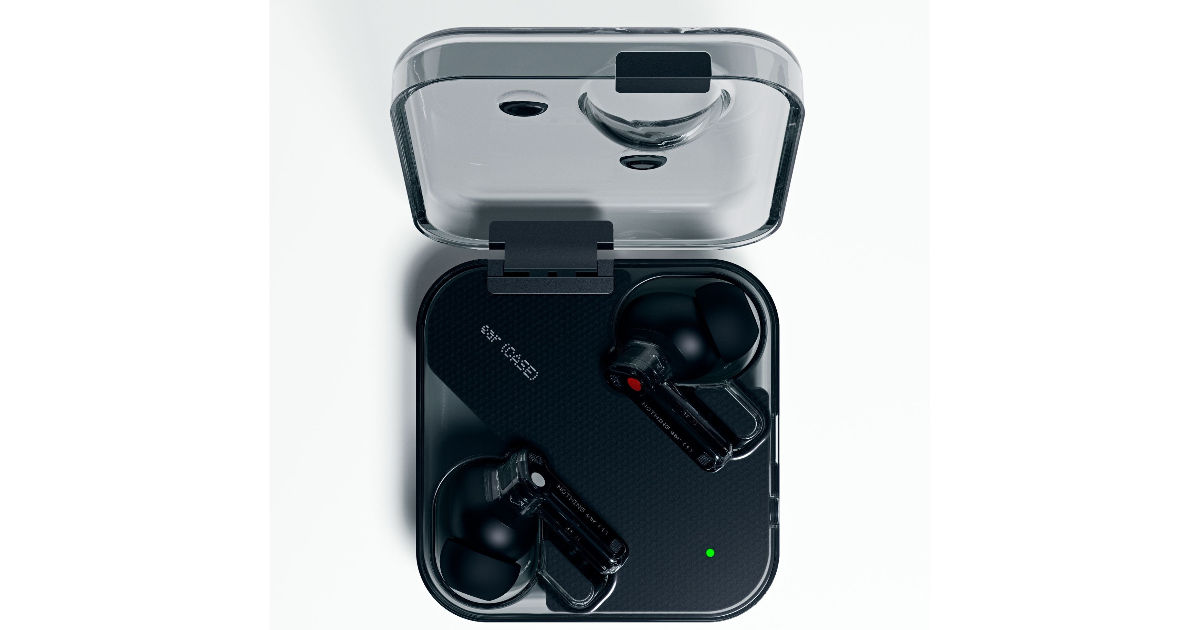
After delivering a solid mid-ranger earlier this year, Nothing’s back with two new audio accessories – the Nothing Ear (a) and Nothing Ear. Yep, the nomenclature is confusing because they’ve messed with a nice chronological numbering system. But they seem to have got a lot of other things right. That’s good, but are they worthy of a rather steep original price of Rs 7,999? Find out in my review of the Nothing Ear (a).
Nothing Ear (a)
Rs 7,999What Is Good?
- Good ANC
- Funky design
- Decent soundstage
- Comfortable to wear
- LDAC support
What Is Bad?
- Pricey
- Mic’s noise suppression algorithm is too aggressive
- Touch controls could have been better
Nothing Ear (a) Review: Design and build
After the Nothing Stick, this is the first time Nothing has introduced a new design in its audio products. And after two years of toying with just white and black products, Nothing has introduced a yellow variant and a completely new design. It’s almost as if Nothing’s unapologetically saying, “Guys, we just want to make sure this thing looks very different from what we have done in the past”. And… it manages to do just that.

| Build Material | Earbuds: Plastic with glossy stem and matte silicone ear tips; Charging Case: Polycarbonate |
| Weight | Earbuds: 4.8g each; Charging Case: 39.6g |
| Water Resistance | IP54 (buds), IPX5 (case) |
| Colour Options | White, Black, Yellow |
The Ear (a)’s case resembles a box of mints. The lid is transparent, and the rest of the case has a solid colour. They have a significant heft, and their weight is mostly centred. This subconsciously gives you a sense of holding a premium product, even though the case and buds are entirely made of plastic. The fit is secure, and the thin stems of the buds minimise tugging. This keeps the centre of gravity around your earholes, ensuring a comfortable experience. In fact, I’d put them against the LG Tone Free TF7 in terms of comfort.
The case also projected a significant bump in my pocket, so now, it lives in my fanny pack. But because it shares space with other stuff inside, the case already has some battle scars. And I haven’t dared to remove the pre-applied clear protector on the lid. The IP rating for dust resistance is limited to the buds, whereas the entire package gets some sort of protection from water.

The pinch gestures are here this time as well. I wish Nothing had added a pinch and swipe-up gesture for volume. I’m not a big fan of just the pinch gestures because they don’t give much tactile feedback when doing crucial things like pausing a track to listen to a co-worker speak. I prefer tap gestures on a dedicated touch surface with a bump or dimple because of their reliability.
Nothing Ear (a) Review: Sound and hardware
The Ear (a) packs the smallest dynamic driver ever in Nothing’s audio products. Still, it doesn’t result in any perceptible difference in overall aural characteristics compared to their previous products. Going by the pricing and the specifications, I believe the closest competitor to Nothing Ear (a) is the OnePlus Buds 3.
| Attribute | Nothing Ear (a) | OnePlus Buds 3 |
| Drivers | 11mm dynamic driver | 10.4mm woofer + 6mm tweeter (dual drivers) |
| Microphones | 3 mics per bud | 3 mics per bud |
| Bluetooth Codec | LDAC/AAC/SBC | LHDC 5.0 / AAC / SBC |
| Active Noise Cancellation (ANC) | Up to 45dB (Four levels: High, Mid, Low, Adaptive) | Up to 49dB (Three levels: Mild, Moderate, Deep) |
| Bass Algorithm | Yes | Yes |
It’s still tuned to have a springy bass, which tends to sit well with its target audience – energy-packed young adults. It comes with a bass enhance algorithm. The bass isn’t so overpowering that it squeezes the vocals in the mix, but enough to keep you entertained on a ride back home.

I felt the urge to tweak the high frequencies in the equaliser when listening to rock and blues music because some heavily processed guitar solos sounded listless in the stock configuration. The soundstage is decent, not as wide as something like an OPPO Enco X2 Pro, but it’s accommodating enough to listen to an occasional jazz track.
On the plus side, these buds are also Hi-Res Wireless Audio certified so that you can play lossless music at up to 990kbps, 24bits/96kHz.
Here’s my observation on the things I listened to test the buds. All content was heard on Apple Music/Podcasts at 90% volume and LDAC quality. Songs were heard once with the stock equaliser, and then with a custom equaliser (Bass +4, Mids 0 and Treble 6). Podcasts were heard first with stock and then with the Voice preset.
| Song/Podcast | Remarks |
| Gula – Deadmau5 | Clear reproduction of the warm, slow pulsing bassline in the intro. No distortion was observed in the violent bass drop. Best experienced in the stock equaliser setting. |
| Lenny – Stevie Ray Vaughan | Stock settings made the wah-wah guitar solo sound underwhelming. The custom equaliser made the guitar’s overall expression much better. |
| Can’t Wait For Perfect – Bob Reynolds | Wide enough soundstage to accommodate the power quintet of a saxophone, two guitars, drums and bass. The texture of the bass and saxophone was well-pronounced in the stock equaliser, raising the treble brought even more life to the mix. |
| Stairway to Heaven – Led Zeppelin | Robert Plant’s vocals sound clean, even with the arpeggio of guitars. Jimmy Page’s solo sounded better with the custom equaliser. |
| She Wolf – Shakira | Shakira’s breathy voice was represented properly. The distorted electric guitar in the mix couldn’t quite cut through the percussive loop, even in the custom equaliser. |
| Galat Karam – Panther x Raaga | Stock equaliser does well to capture the high-octane performance. Clean vocals of rap verses. |
| MotorInc First Podcast – Bajaj Pulsar NS200 2024 | Overall, the sound signature was too warm in the stock equaliser. Switching to the Voice preset helped reduce the overtones in the deep voices of Shumi and Kartikeya. |
Despite the tweaking required, I’m happy with the overall performance of the buds. I just wish the loudness of the buds could be raised by a few notches, but the smaller driver size does limit this.
Nothing Ear (a) Review: ANC and mic quality
The Ear (a) ups the ante by increasing the noise cancellation threshold to 45dB. It utilises a ‘Smart ANC algorithm’, which automatically checks the seal of each earbud to minimise sound leakage. The ANC has three levels (high, low and medium). These features can be seen in other buds of the same price with different names.

I would rate it as one of the best noise cancellation for the price, offering nice, even noise suppression. It worked well, even in a five-hour flight. I also didn’t notice any ‘eardrum suck’ with the ANC enabled. The transparency mode is also good, letting voices pass through easily when listening to music at low volume. It doesn’t give you superhuman hearing, but it’s still good.
To capture sounds, the Ear (a) comes with three mics on each bud, aided by the Clear Voice algorithm. There’s also a hole to let wind pass through to reduce noise. In reality, I would rate the mic performance as average. The algorithm is a bit too aggressive when suppressing ambient noise, so my voice often sounded tinny to the recipient.
Nothing Ear (a) Review: Companion app
The companion Nothing X app offers a nifty way to tailor your Nothing Ear (a) experience. You can tweak your equaliser, which has a unique visualiser, change the ANC setting, and check whether your ears have a good seal for optimal ANC performance. It also displays the battery life of both the earbuds and the charging case. However, it does miss out on a 3D spatial audio mode, which many competitors provide.
Nothing Ear (a) Review: Battery life
The battery life on these buds is good for the features. The charging cases at this price tend to have a battery capacity ranging between 450 to 500mAh, with an overall playback time of about 30 hours. The Ear (a) easily matches this without breaking a sweat.

Per session, with a mix of ANC and transparency mode, it squeezed out an average of about six hours of playtime. During all the sessions, LDAC audio was turned on. The case is capable of holding another four charges. It charges up entirely within 45 minutes, and within 10 minutes, you can get about a day’s worth of charge.
Nothing Ear (a) Review: Verdict
Compared to the more expensive Nothing Ear, the Ear (a) offers much better value for money. These buds don’t claim to have audiophile characteristics and are made for easy listening. While I’d leave the design and colours up to you, I enjoyed the lively sound profile, ANC, transparency, and battery life of the Ear (a). Louder sound, a more natural mic output, and a unique texture around the touch-sensitive areas would have made these even better.
It faces fierce competition from the OnePlus Buds 3. They are more affordable but have a more generic design as well. They, too, lean towards a bassier sound. The Ear (a) with its special launch price of Rs 5,999 is a good deal, so try grabbing one during this time.



